News & "Stroke rate and rowing efficiency"

News
This 240th issue celebrates the 20 year anniversary of this monthly Rowing Biomechanics Newsletter, which was started in April 2001, thanks to the advice of my good friend Gennadi Touretski, a phenomenal swimming coach who sadly passed away last year. Gennadi helped me find the most efficient way to communicate with the audience in my area of expertise: rowers, coaches and rowing scientists. Before that, I tried to do it with publications in scientific journals but found too many obstacles on that path. Running this project for many years keeps me in a good professional “shape” and allows me to assemble the many pieces of the puzzle of rowing biomechanics, which were compiled into two editions (2015 and 2020) of my book “Biomechanics of Rowing”.
I would like to express great thanks to all the readers, contributors and translators of the Rowing Biomechanics Newsletter for their continuous interest and very valuable feedback: comments, questions and ideas, which always help to verify my data and analysis, to find new research directions and practical applications of Rowing Biomechanics.
Upcoming events
Together with Bill Chambers, we are running an online Live Master Class on the 10th April, 2021 at 20:00 ZĂĽrich time, 15:00 Eastern US time.
The topic is “Biomechanics for Fast and Efficient Rowing”, where you will learn how different technique and different boat set-up can help you to achieve your best race results. I’ll present my insights and observations of what that the world's best do to go fast, and practical applications for you to apply to your own rowing. We will discuss and demystify some of the most common rowing myths: “boat check” & “stopping the boat”, as well as “blade inefficiency at the catch”, and replace them with correct definitions of the boat and blade propulsive efficiencies, inertial and rower’s effectiveness.
This Master Class is planned as:
• 90-minutes Live on Zoom
• Interactive presentation
• Q&A time with Valery
Session recorded for playback after Master Class. For more information, please visit Bill’s page here:
https://whchambers.com/rowing-fast/live-master-classes/
Stroke rate and rowing efficiency
In this month’s newsletter we will continue to discuss the effects of the stroke rate on various areas of rowing biomechanics.
The quality of blade work usually degrades at higher stroke rates: Catch Slip (Fig.1) gets longer by 2-3deg in sculling and 4-6 deg in rowing. Release Slip increases about 4deg in sculling and 8 deg in rowing. Effective Angle decreases by 6% in sculling and 15% in rowing. The reason for this is an inadequate response in vertical handle movements to increasing horizontal handle velocity.
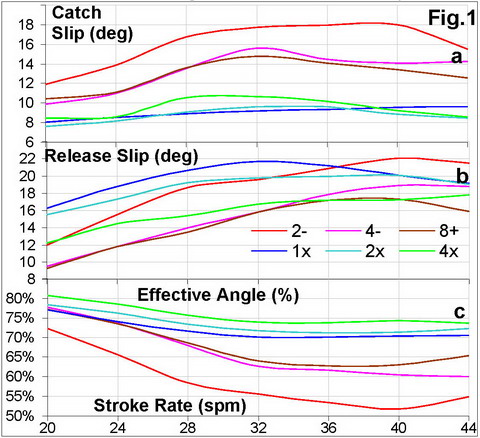
At high rates, the handle moves much faster horizontally, but rowers usually do not increase the vertical handle speed proportionally at the catch and finish.
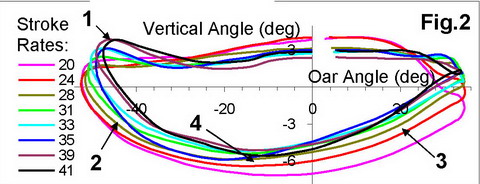
Fig.2 shows typical changes of the blade work at increasing stroke rate: more “skying” before catch (1), longer catch (2) and release (3) slips, and shallower blade path (4). To address this problem, at any stroke rate, rowers need to emphasise a quick (but short) vertical handle movement at catch and finish. A rower should try to make the handle path rectangular (push-up-pull-down), rather than linear (pull-push).
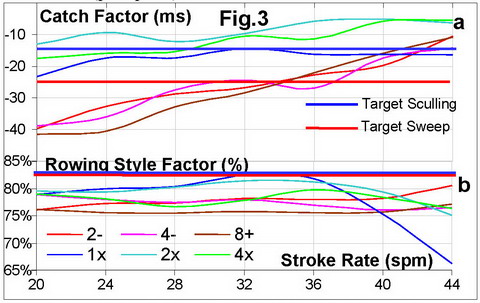
The Catch Factor (Fig.3,a) tends towards more positive values at higher rates: the handle changes direction earlier than the seat. At 32-36spm, the Catch Factor is the closest to its target values -15ms in sculling and -25ms in rowing. Rowing Style Factor (Fig.3,b) is practically not affected by stroke rate, except single scullers at high rates, who “open the trunk” earlier.
To analyse the effect of SR on crew synchronisation, averages of the absolute values of timing of each rower from the stroke at 12 selected points (RBN 2014/05, 2015/03) were used. It was found that crew synchronisation of the handle (Fig.4,a) and seat movements (b) at catch improves more than twice from SR 20 to 44 spm. This means, at high rates, rowers change the direction of the handle and seat (most important) at the catch more synchronously, which emphasises the importance of regular practice at high rates for the development of good crew synchronisation. Interestingly, synchronisation of the Peak Force Position (Fig.4,c) does not change with stroke rate, which is probably related to the consistency of an individual’s pattern of force application.

Fig.5 shows an example of crew synchronisation in a National level W8+ at 20 and 42 spm. At high rate, timing of the seat changing direction at the catch became much better than at low rate, which plays the highest role in crew effectiveness, because it relates to the movements of the rowers’ mass relative the boat and defines inertial efficiency of the system (“trampoline effect”, etc.).
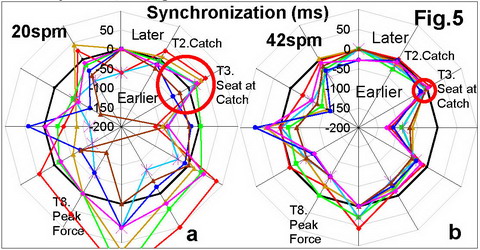
Rowing Power grows at higher stroke rates, but inertial losses (RBN 2010/05) increase more significantly (Fig.6,a). Ratio of inertial losses to rowing power increases from 6% at 20spm up to 14% at 44spm (b), so inertial efficiency decreases from 94% down to 86% at these rates. This means, at higher rates, rowers must pay a higher “inertial price” to gain rowing power, so increasing the stroke rate above 42-44 spm could be too “expensive” and ineffective for the standard 2km race. However, for short sprints, stroke rates up to 48spm could still be useful, if rowing power increases more than inertial losses, i.e. rowers preserve or increase Work per Stroke by means of maintaining the stroke length and handle force.
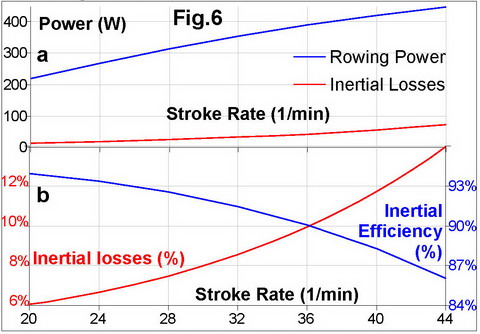
Conclusions. Rowing Biomechanics and technique are very different at low and high stroke rates. High rates differ by faster rower’s movements and better crew synchronisation, but lower quality of blade work and increased inertial losses.
In many cyclic sports (rowing, swimming, canoeing, etc.), most of the training time is spent at moderate intensity at low stroke rates, which has two purposes: 1) Base aerobic training; 2) Muscles adaptation to movements non-specific for humans (this is not an issue for natural locomotions like running and walking). However, sub-maximal racing stroke rates (cadences) are used at competitions, which require very different biomechanics and technique (“the difference is like between walking and running”). This creates the main technical problem in cyclic sports: how does one develop and maintain racing technique during large training volumes at low rates?
The only solution of this problem is the constant practice of high racing rates during the whole season to maintain racing technique during base training at low rates. It is a good idea to include short 20-30s bursts into long steady-state workouts, which does not create excessive lactate, and even helps to improve aerobic training and lactate utilisation. Specific details of racing technique must always be practised, which may look like an exaggeration at low training rates, but fit well to racing rates: quick vertical handle movements at the catch and finish, racing rhythm with “bouncing” from the stretcher, quick legs drive and steep force gradient. Finally, high-rate workouts help to develop better crew synchronisation, improve inertial efficiency and achieve better results.
Acknowledgments. Thanks to Miles Forbes-Thomas for very specific questions and idea of this Newsletter.
©2021 Dr. Valery Kleshnev www.biorow.com



